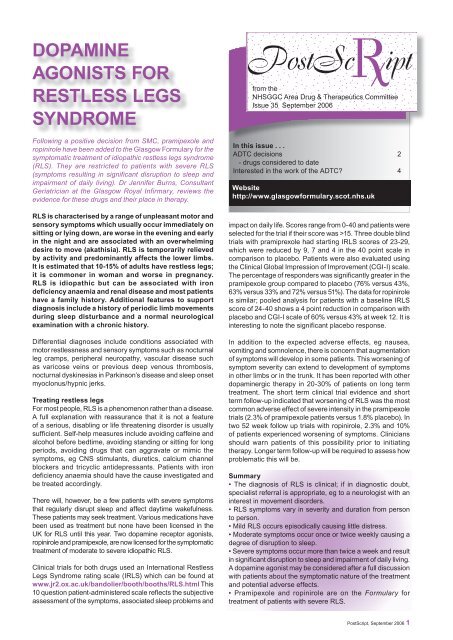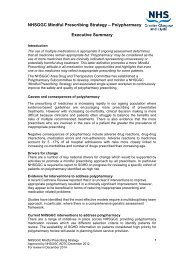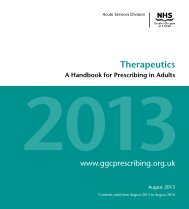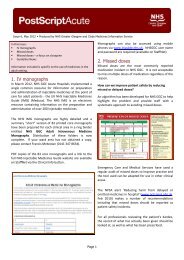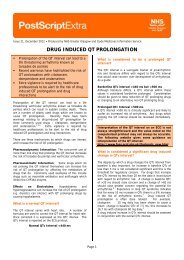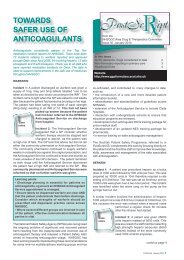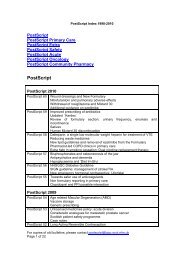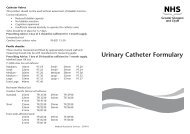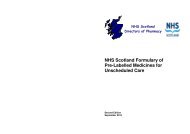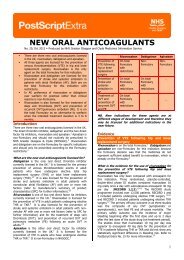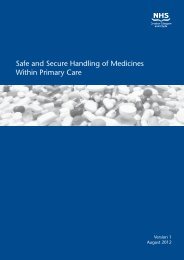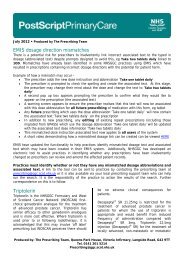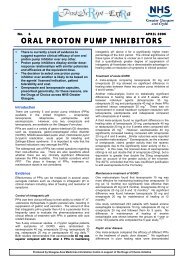dopamine agonists for restless legs syndrome - GGC Prescribing
dopamine agonists for restless legs syndrome - GGC Prescribing
dopamine agonists for restless legs syndrome - GGC Prescribing
You also want an ePaper? Increase the reach of your titles
YUMPU automatically turns print PDFs into web optimized ePapers that Google loves.
DOPAMINE<br />
AGONISTS FOR<br />
RESTLESS LEGS<br />
SYNDROME<br />
Following a positive decision from SMC, pramipexole and<br />
ropinirole have been added to the Glasgow Formulary <strong>for</strong> the<br />
symptomatic treatment of idiopathic <strong>restless</strong> <strong>legs</strong> <strong>syndrome</strong><br />
(RLS). They are restricted to patients with severe RLS<br />
(symptoms resulting in significant disruption to sleep and<br />
impairment of daily living). Dr Jennifer Burns, Consultant<br />
Geriatrician at the Glasgow Royal Infirmary, reviews the<br />
evidence <strong>for</strong> these drugs and their place in therapy.<br />
RLS is characterised by a range of unpleasant motor and<br />
sensory symptoms which usually occur immediately on<br />
sitting or lying down, are worse in the evening and early<br />
in the night and are associated with an overwhelming<br />
desire to move (akathisia). RLS is temporarily relieved<br />
by activity and predominantly affects the lower limbs.<br />
It is estimated that 10-15% of adults have <strong>restless</strong> <strong>legs</strong>;<br />
it is commoner in woman and worse in pregnancy.<br />
RLS is idiopathic but can be associated with iron<br />
deficiency anaemia and renal disease and most patients<br />
have a family history. Additional features to support<br />
diagnosis include a history of periodic limb movements<br />
during sleep disturbance and a normal neurological<br />
examination with a chronic history.<br />
Differential diagnoses include conditions associated with<br />
motor <strong>restless</strong>ness and sensory symptoms such as nocturnal<br />
leg cramps, peripheral neuropathy, vascular disease such<br />
as varicose veins or previous deep venous thrombosis,<br />
nocturnal dyskinesias in Parkinson’s disease and sleep onset<br />
myoclonus/hypnic jerks.<br />
Treating <strong>restless</strong> <strong>legs</strong><br />
For most people, RLS is a phenomenon rather than a disease.<br />
A full explanation with reassurance that it is not a feature<br />
of a serious, disabling or life threatening disorder is usually<br />
sufficient. Self-help measures include avoiding caffeine and<br />
alcohol be<strong>for</strong>e bedtime, avoiding standing or sitting <strong>for</strong> long<br />
periods, avoiding drugs that can aggravate or mimic the<br />
symptoms, eg CNS stimulants, diuretics, calcium channel<br />
blockers and tricyclic antidepressants. Patients with iron<br />
deficiency anaemia should have the cause investigated and<br />
be treated accordingly.<br />
There will, however, be a few patients with severe symptoms<br />
that regularly disrupt sleep and affect daytime wakefulness.<br />
These patients may seek treatment. Various medications have<br />
been used as treatment but none have been licensed in the<br />
UK <strong>for</strong> RLS until this year. Two <strong>dopamine</strong> receptor <strong>agonists</strong>,<br />
ropinirole and pramipexole, are now licensed <strong>for</strong> the symptomatic<br />
treatment of moderate to severe idiopathic RLS.<br />
Clinical trials <strong>for</strong> both drugs used an International Restless<br />
Legs Syndrome rating scale (IRLS) which can be found at<br />
www.jr2.ox.ac.uk/bandolier/booth/booths/RLS.html This<br />
10 question patient-administered scale reflects the subjective<br />
assessment of the symptoms, associated sleep problems and<br />
from the<br />
NHS<strong>GGC</strong> Area Drug & Therapeutics Committee<br />
Issue 35 September 2006<br />
In this issue . . .<br />
ADTC decisions 2<br />
- drugs considered to date<br />
Interested in the work of the ADTC 4<br />
Website<br />
http://www.glasgow<strong>for</strong>mulary.scot.nhs.uk<br />
impact on daily life. Scores range from 0-40 and patients were<br />
selected <strong>for</strong> the trial if their score was >15. Three double blind<br />
trials with pramiprexole had starting IRLS scores of 23-29,<br />
which were reduced by 9, 7 and 4 in the 40 point scale in<br />
comparison to placebo. Patients were also evaluated using<br />
the Clinical Global Impression of Improvement (CGI-I) scale.<br />
The percentage of responders was significantly greater in the<br />
pramipexole group compared to placebo (76% versus 43%,<br />
63% versus 33% and 72% versus 51%). The data <strong>for</strong> ropinirole<br />
is similar; pooled analysis <strong>for</strong> patients with a baseline IRLS<br />
score of 24-40 shows a 4 point reduction in comparison with<br />
placebo and CGI-I scale of 60% versus 43% at week 12. It is<br />
interesting to note the significant placebo response.<br />
In addition to the expected adverse effects, eg nausea,<br />
vomiting and somnolence, there is concern that augmentation<br />
of symptoms will develop in some patients. This worsening of<br />
symptom severity can extend to development of symptoms<br />
in other limbs or in the trunk. It has been reported with other<br />
<strong>dopamine</strong>rgic therapy in 20-30% of patients on long term<br />
treatment. The short term clinical trial evidence and short<br />
term follow-up indicated that worsening of RLS was the most<br />
common adverse effect of severe intensity in the pramipexole<br />
trials (2.3% of pramipexole patients versus 1.8% placebo). In<br />
two 52 week follow up trials with ropinirole, 2.3% and 10%<br />
of patients experienced worsening of symptoms. Clinicians<br />
should warn patients of this possibility prior to initiating<br />
therapy. Longer term follow-up will be required to assess how<br />
problematic this will be.<br />
Summary<br />
• The diagnosis of RLS is clinical; if in diagnostic doubt,<br />
specialist referral is appropriate, eg to a neurologist with an<br />
interest in movement disorders.<br />
• RLS symptoms vary in severity and duration from person<br />
to person.<br />
• Mild RLS occurs episodically causing little distress.<br />
• Moderate symptoms occur once or twice weekly causing a<br />
degree of disruption to sleep.<br />
• Severe symptoms occur more than twice a week and result<br />
in significant disruption to sleep and impairment of daily living.<br />
A <strong>dopamine</strong> agonist may be considered after a full discussion<br />
with patients about the symptomatic nature of the treatment<br />
and potential adverse effects.<br />
• Pramipexole and ropinirole are on the Formulary <strong>for</strong><br />
treatment of patients with severe RLS.<br />
PostScript, September 2006
Alphabetical list of most recent ADTC decisions<br />
For full details of SMC advice, visit www.scottishmedicines.org For previous ADTC decisions, visit www.glasgow<strong>for</strong>mulary.scot.nhs.uk<br />
Drug Indication under consideration Glasgow decision<br />
(There may be other licensed indications)<br />
Beclometasone<br />
(Clenil Modulite®)<br />
Bortezomib (Velcade®)<br />
Budesonide<br />
(Novolizer®)<br />
Carbetocin (Pabal®)<br />
Cetuximab (Erbitux®)<br />
Clobetasol propionate<br />
cutaneous foam<br />
(Clarelux®)<br />
Desmopressin<br />
oral lyophilisate<br />
(DesmoMelt®)<br />
Dinoprostone vaginal<br />
delivery system<br />
(Propess®)<br />
Docetaxel (Taxotere®)<br />
Duloxetine (Cymbalta®)<br />
Efalizumab (Raptiva®)<br />
Erlotinib (Tarceva®)<br />
Ertapenem (Invanz®)<br />
Etanercept (Enbrel®)<br />
Fondaparinux<br />
(Arixtra®)<br />
Prophylactic management of mild, moderate or severe<br />
asthma in adults or children.<br />
Monotherapy <strong>for</strong> progressive multiple myeloma in<br />
patients who have received at least one prior therapy<br />
and who have already undergone or are unsuitable <strong>for</strong><br />
bone marrow transplantation.<br />
Persistent asthma in adults and children >6 years.<br />
Prevention of uterine atony and excessive bleeding<br />
following delivery of the infant by Caesarean section<br />
under epidural or spinal anaesthesia.<br />
In combination with radiation therapy <strong>for</strong> the treatment<br />
of patients with locally advanced squamous cell cancer<br />
of the head and neck.<br />
Short-course treatment of steroid responsive dermatoses<br />
of the scalp such as psoriasis, which do not respond<br />
satisfactorily to less potent steroids.<br />
Primary nocturnal enuresis.<br />
Initiation of cervical ripening in patients at term (from<br />
38th week of gestation).<br />
Hormone-refractory metastatic prostate cancer.<br />
Diabetic peripheral neuropathic pain in adults.<br />
Psoriasis.<br />
Locally advanced or metastatic non small cell lung<br />
cancer, after failure of at least one prior chemotherapy<br />
regimen.<br />
Treatment of intra-abdominal infections in children and<br />
adolescents.<br />
• Moderate to severe active rheumatoid arthritis in<br />
adults.<br />
• Psoriasis<br />
Prevention of venous thromboembolic events in patients<br />
undergoing abdominal surgery.<br />
Formulary. Acknowledge new<br />
<strong>for</strong>mulation.<br />
Non-Formulary.<br />
F o r m u l a r y. A c k n o w l e d g e n e w<br />
<strong>for</strong>mulation.<br />
Non-Formulary.<br />
Formulary, subject to review of place in<br />
therapy by Regional Cancer Advisory<br />
Network.<br />
Restricted to patients who are not<br />
appropriate <strong>for</strong> or unable to tolerate<br />
chemo-radiotherapy and who are of good<br />
per<strong>for</strong>mance status with no evidence of<br />
distant metastases. Restricted to use by<br />
specialists in the management of head<br />
and neck cancer.<br />
Formulary. Acknowledge new<br />
<strong>for</strong>mulation.<br />
Formulary. Acknowledge new<br />
<strong>for</strong>mulation.<br />
Decision deferred <strong>for</strong> consultation with<br />
consultant obstetricians.<br />
Formulary. Acknowledge new indication.<br />
Restricted to use by specialists <strong>for</strong><br />
patients with a Karnofsky per<strong>for</strong>mancestatus<br />
score is 60% or more, in line with<br />
NICE Technology Appraisal 101.<br />
Formulary. Acknowledge new indication.<br />
Restricted to initiation by prescribers<br />
experienced in the management of<br />
diabetic peripheral neuropathic pain, as<br />
second or third line therapy.<br />
Formulary. Restricted to initiation and<br />
supervision by specialist physicians<br />
in accordance with NICE Technology<br />
Appraisal 103.<br />
Decision deferred to allow consultation<br />
with the Regional Cancer Advisory<br />
Group.<br />
Formulary. Acknowledge new indication.<br />
Restricted to second line use under the<br />
advice of microbiologists or specialists<br />
in infectious diseases <strong>for</strong> community<br />
ac quired infections resist ant to<br />
conventional treatments.<br />
• Formulary. Acknowledge new<br />
<strong>for</strong>mulation<br />
• Formulary. Acknowledge new<br />
indication<br />
Non-Formulary.<br />
√<br />
x<br />
√<br />
x<br />
√<br />
√<br />
√<br />
√<br />
√<br />
√<br />
√<br />
√<br />
√<br />
x<br />
Drug Indication under consideration Glasgow decision<br />
(There may be other licensed indications)<br />
Ibandronic acid<br />
(Bonviva®)<br />
Infliximab (Remicade®)<br />
Insulin glulisine<br />
(Apidra®)<br />
Insulin, inhaled<br />
(Exubera®)<br />
Lansoprazole (Zoton<br />
FasTab®)<br />
Losartan /<br />
hydrochlorothiazide<br />
(Cozaar-Comp®)<br />
Nebivolol (Nebilet®)<br />
Paricalcitol (Zemplar®)<br />
Pegaptanib (Macugen®)<br />
Pioglitazone / met<strong>for</strong>min<br />
(Competact®)<br />
Pregabalin (Lyrica®)<br />
Rivastigmine (Exelon®)<br />
Ropinirole (Adartrel®)<br />
Rosiglitazone/<br />
met<strong>for</strong>min<br />
(Avandamet®)<br />
Rotigotine (Neupro®)<br />
Salmeterol (Serevent<br />
Evohaler®)<br />
Testosterone (Nebido®)<br />
Osteoporosis in postmenopausal women to reduce the<br />
risk of vertebral fractures.<br />
Psoriatic arthritis.<br />
Diabetes mellitus in adults where treatment with a shortacting<br />
insulin analogue is appropriate.<br />
Adults with type 2 diabetes mellitus not adequately<br />
controlled with oral antidiabetic agents and requiring<br />
insulin, or adults with type 1 diabetes mellitus, in addition<br />
to long or intermediate acting subcutaneous insulin.<br />
Use in patients <strong>for</strong> whom a proton pump inhibitor is<br />
appropriate and who cannot tolerate capsules because<br />
of feeding tubes and dysphagia.<br />
Essential hypertension in patients whose blood pressure<br />
is not adequately controlled on hydrochlorothiazide or<br />
losartan monotherapy.<br />
Stable mild and moderate chronic heart failure with<br />
standard therapies in patients ≥70 years.<br />
P r e v e n t i o n a n d t r e a t m e n t o f s e c o n d a r y<br />
hyperparathyroidism in patients with chronic renal failure<br />
undergoing haemodialysis.<br />
Neovascular (wet) age-related macular degeneration.<br />
Type 2 diabetes mellitus in overweight patients unable<br />
to achieve sufficient glycaemic control at maximally<br />
tolerated doses of met<strong>for</strong>min.<br />
Treatment of peripheral neuropathic pain in adults.<br />
Mild to moderately severe dementia in patients with<br />
idiopathic Parkinson’s disease.<br />
Moderate to severe idiopathic <strong>restless</strong> <strong>legs</strong> <strong>syndrome</strong><br />
(RLS).<br />
In combination with a sulphonylurea, as triple oral therapy<br />
in patients (particularly overweight patients) unable to<br />
achieve sufficient glycaemic control despite dual oral<br />
therapy and unable or unwilling to take insulin.<br />
Monotherapy <strong>for</strong> the signs and symptoms of early-stage<br />
idiopathic Parkinson’s disease.<br />
Regular symptomatic treatment of reversible airways<br />
obstruction in patients with asthma or COPD and<br />
prevention of exercise-induced asthma.<br />
Adult male hypogonadism when testosterone deficiency<br />
has been confirmed by clinical features and biochemical<br />
tests.<br />
Formular y. Restricted to patients<br />
unsuitable <strong>for</strong> or unable to tolerate oral<br />
treatment options. Treatment initiation<br />
should be under specialist supervision.<br />
Formulary. Acknowledge new indication.<br />
Restricted to criteria in NICE Technology<br />
Appraisal 104.<br />
Formulary. Restricted to patients <strong>for</strong> whom<br />
regular human insulin is inappropriate.<br />
Non-Formulary.<br />
Formulary. Restricted <strong>for</strong> specialist<br />
initiation in patients with narrow-bore<br />
feeding tubes.<br />
Non-Formulary.<br />
Non-Formulary.<br />
Non-Formulary.<br />
Formulary, subject to referral to the<br />
<strong>Prescribing</strong> Management Group <strong>for</strong><br />
clarification of service delivery aspects.<br />
Restricted to patients with visual acuity<br />
between 6/12 to 6/60 (inclusive). It should<br />
be stopped if visual acuity falls below 6/60<br />
during treatment or severe visual loss is<br />
experienced.<br />
Formulary. Acknowledge new <strong>for</strong>mulation.<br />
Restricted to initiation by physicians<br />
experienced in the treatment of diabetes<br />
mellitus <strong>for</strong> patients who cannot be<br />
treated or controlled with a sulphonylurea<br />
in combination with met<strong>for</strong>min.<br />
Non-Formulary.<br />
Non-Formulary.<br />
Formulary. Acknowledge new indication.<br />
Restricted to use in patients with severe<br />
RLS (symptoms resulting in significant<br />
disruption to sleep and impairment of<br />
daily living).<br />
Formulary. Acknowledge new indication.<br />
Restricted to initiation by physicians<br />
experienced in the treatment of diabetes<br />
mellitus <strong>for</strong> patients who cannot be<br />
treated or controlled with a sulphonylurea<br />
in combination with met<strong>for</strong>min.<br />
Non-Formulary.<br />
Formulary. Acknowledge new<br />
<strong>for</strong>mulation.<br />
Non-Formulary.<br />
√<br />
√<br />
√<br />
x<br />
√<br />
x<br />
x<br />
x<br />
√<br />
√<br />
x<br />
x<br />
√<br />
√<br />
x<br />
√<br />
x<br />
2 PostScript, September 2006 PostScript, September 2006 3
Drug Indication under consideration Glasgow decision<br />
(There may be other licensed indications)<br />
Testosterone gel<br />
(Testim®)<br />
Tigecycline (Tygacil®)<br />
Tipranavir (Aptivus®)<br />
Topiramate (Topamax®)<br />
Travoprost /timolol<br />
(DuoTrav®)<br />
Adult male hypogonadism when testosterone<br />
deficiency has been confirmed by clinical features and<br />
biochemical tests.<br />
• Complicated intra-abdominal infection.<br />
• Complicated skin and soft-tissue infections.<br />
HIV-1 infection in combination with low dose ritonavir<br />
in highly pre-treated adult patients with virus resistant<br />
to multiple protease inhibitors.<br />
Prophylaxis of migraine in adults.<br />
Open-angle glaucoma or ocular hypertension in<br />
patients insufficiently responsive to topical betablockers<br />
or prostaglandin analogues alone.<br />
Formulary. Acknowledge new<br />
<strong>for</strong>mulation. Restricted to use as an<br />
alternative to gel patches <strong>for</strong> patients<br />
requiring transdermal delivery.<br />
• Formulary. Restricted to second line<br />
use under the advice of microbiologists<br />
or specialists in infectious disease.<br />
• Formulary. Restricted to second<br />
or third line use under the advice<br />
of microbiologists or specialists in<br />
infectious diseases.<br />
Formulary. Restricted to use by HIV<br />
specialists <strong>for</strong> patients with tipranavir<br />
mutation score


